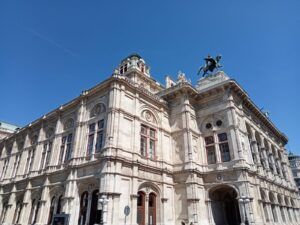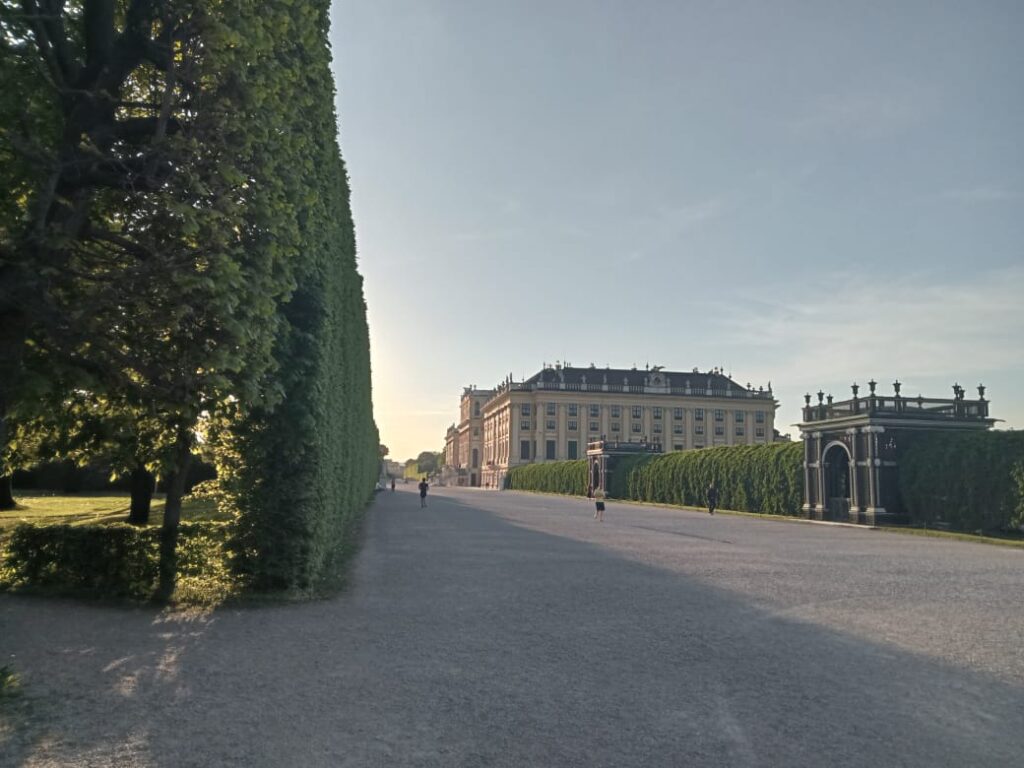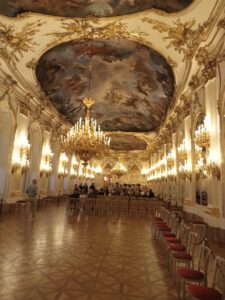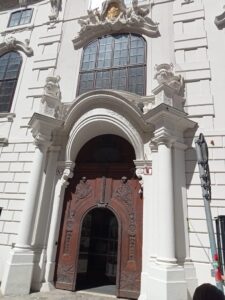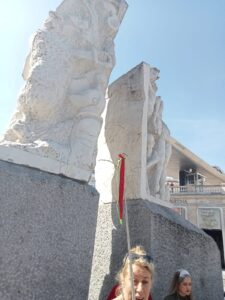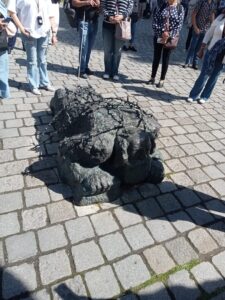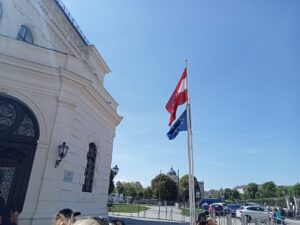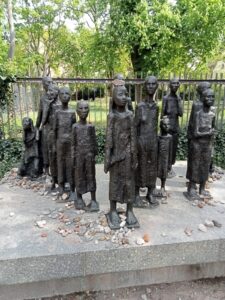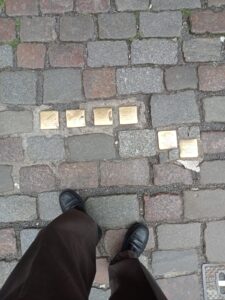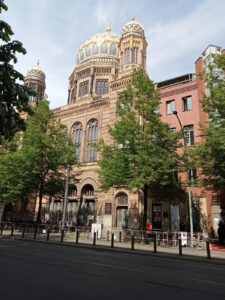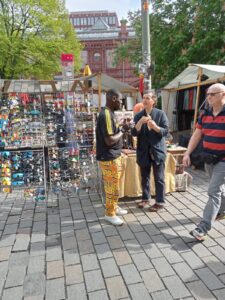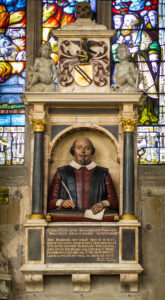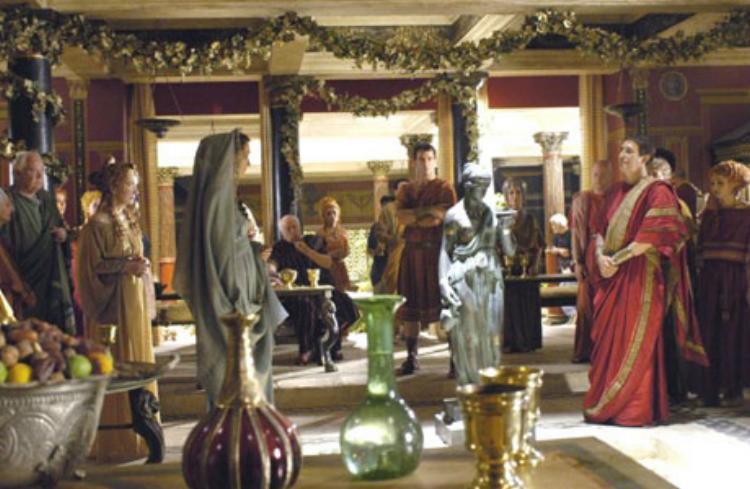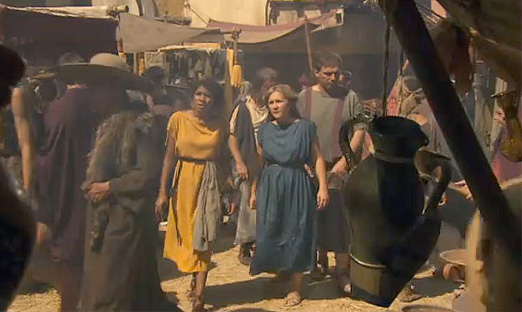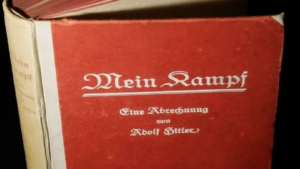 “Blood mixture and the resultant drop in the racial level is the sole cause of the dying out of old cultures; for men do not perish as a result of lost wars, but by the loss of that force of resistance which is contained only in pure blood”.
“Blood mixture and the resultant drop in the racial level is the sole cause of the dying out of old cultures; for men do not perish as a result of lost wars, but by the loss of that force of resistance which is contained only in pure blood”.
Category: Miscegenation
Zero
Lebenskraft ! (6)
Vienna
29th and 30th April
When I got off the bus in Vienna on the Ringstrasse, what caught my attention next to the multitude of historic buildings was the Vienna State Opera because it was the theatre where the teenage Adolf used to enter despite his meagre resources. I took several pictures of it but I chose this one:
In a 21st century Reich under the leaders who would have followed a Hitler who would have died a very old, natural death, say in 1987, there would be no non-Aryans in this area. Not even the non-Aryan tourists I saw en masse here.
I sat in a café on a pedestrian street close to the Opera House to watch the pedestrians calmly having a coffee and a slice of cake (Austria is expensive, I paid 17.4 €). I noticed that, among the white people passing by, the race was better than the ones I had seen the previous couple of days.
Recall that Austria is the homeland of Hitler, whose Aryans rank among the highest in the European IQ. Alas, it wasn’t long before I saw, holding hands, the first mixed couple: an Aryan male and a woman who was either Muslim or Indian. If Putin weren’t celebrating his victory these days, it would have been inconceivable to see so many non-whites in this sacred area! From my vantage point I spent about an hour and a half watching the people pass by. Eventually another mixed couple sat behind me. This time I didn’t hold back and took a picture of them from behind me, so my shoulder is visible:
 If the contemporary Austrian were not an iniquitous person, it would be legal to execute this couple on the spot but, as we know, besides the Russians the Anglo-Saxons won the war. Recall that, because of Christian ethics, the United States began to repudiate anti-miscegenation laws long before the Jews took over its media: historical facts that American racialists ignore because they debunk their Judeo-reductionist paradigm.[1]
If the contemporary Austrian were not an iniquitous person, it would be legal to execute this couple on the spot but, as we know, besides the Russians the Anglo-Saxons won the war. Recall that, because of Christian ethics, the United States began to repudiate anti-miscegenation laws long before the Jews took over its media: historical facts that American racialists ignore because they debunk their Judeo-reductionist paradigm.[1]
However, it isn’t clear, about the two mixed couples I saw, that they have already sinned against the holy spirit of life (once a mongrel baby is conceived, the sin can no longer be forgiven and the whole family would have to be sent to Auschwitz II).
Not long after I saw the third mixed couple pass by, but I didn’t have time to take a picture of them. The lack of real hatred among white nationalists is what I can’t stand—except Pierce, who dedicated one of his novels to a serial killer of mixed couples. (In conquered Austria these poor devils don’t have a First Amendment; a book like Pierce’s could never be published here!).
If I write harsh things in this entry it is because where I sat, so close to the elegant theatre that the teenage Adolf visited, would be hallowed ground in a world where the good guys would have won. It is a real sacrilege the sight of so many coloureds here.
However, I did get to see two women who could perfectly well have modelled Maxfield Parrish for one of his ‘nymphs on the rocks’ paintings. I also felt very good when a white woman passed by carrying her white baby on her chest. This reminds me of something I omitted when I visited Berlin’s Jewish Quarter: a very touristy place. I saw an Aryan couple with a couple of small children with pinkish-white skin and the most Scandinavian hair one could imagine: a very comforting moment for me, one of the very few good moments of the trip! But the number of non-whites I saw in Vienna never ceased to amaze me, even if it was impossible to tell who were tourists and who were residents.
Before taking the bus to my hotel, I made enquiries at the Vienna State Opera, which was showing Lohengrin in a couple of days. A pity, as I had scheduled that day to go to Munich. I entertained the idea of changing my plans but I was a slave to the day I was already scheduled in Frankfurt to return to the American continent. I still wanted to change my plans but I remembered what, a decade earlier, had happened to me at Shakespeare’s Globe in London: they put on black actors. Would the Germans do a similar sacrilege with Lohengrin, whose lavish 1936 production delighted Hitler?
So I didn’t change my plans and headed back to my hotel. I was struck by the graffiti on the other side of the street: inconceivable if patriotic Austrians and Germans had prevailed in the war. After some rest, instead of seeing Wagner’s grandiose opera in a couple of days, I went more modestly to Schönbrunn Palace to listen to some waltzes. Before entering the palace I spent some time in the very beautiful and well-kept palace gardens (all this will disappear, of course, when the Austrian Aryan disappears).
I would like to add something about these beautiful palace gardens. It hurts to see young women, beautiful Aryan women, walking alone there. They should be married, walking with their husbands and with children as beautiful as they are. But this is the world bequeathed to us by the individualistic liberalism imposed by the American Diktat. Then I left the gardens and headed for the concert hall.
I took this picture before the performance because, once the concert started, we were no longer allowed to photograph them. My fears about Lohengrin might have been well-founded! During the waltzes a duo appeared: a good-looking Aryan male and the Nigerian-born but Austrian-educated soprano, Bibiana Nwobilo. In several waltzes they embraced and the singer even kissed the hand of this female with her afro hair….
I never applauded the pieces in which the Nigerian sang, despite her excellent voice. What shocked me was that there were Viennese older than me: Aryans whose parents may have fought for Hitler, but they applauded with pleasure. If these guys had any vestige of Lebenskraft left, they simply wouldn’t attend any concert starring non-Aryans. All these people are victims of what I call the ‘ogre of the superego’: the perennial anti-Nazi propaganda that goes to the core of the Austrian soul with the same virulence that Monica’s frequent harangues struck young Augustine. The infinite power over the normies of the omnipresent propaganda that reigns in these lands never ceases to amaze me…
The next day I continued sightseeing in Vienna.
To the humiliation of German speakers, here is another monument commemorating the Russian fallen in the Second World War. Kenneth Clark was right: to understand a culture, look at its architecture, including monuments, for there is nothing even remotely commemorating the German or Austrian heroes who fell in that war, or even their children. The millions of men, women and children killed by the Allies are worth zero. By contrast, in the zeitgeist at work, the Jewish victims have infinite value. The fact that urban guerrillas have not dynamited these monuments speaks of the ubiquity of zero Lebenskraft in the collective Aryan unconscious. The System has them controlled by pleasure, as Kerry Bolton saw so well about the degenerate Westerner, and Vienna has a very high standard of living.
I passed the avenue where, before WW2, the richest Jews lived, where we see an equestrian statue of an Austrian who fought against Napoleon. The opera house where Lohengrin was to be performed the next day was badly damaged by Allied bombing. Not far from there we can see statues of Goethe and Mozart; it is also a museum area. Further on we see the Parliament and it is refreshing to see the statue of Pallas Athena. But not far from there the Vienna quack (Freud) had his favourite café! Beethoven lived in Vienna for a while and in this theatre they premiered the Eroica Symphony, which made a tremendous impact on the pubescent boy I was decades ago:
Due to flooding, the Danube was divided into parts in Vienna. On the Danube Canal, an area that had also been badly damaged by gringo bombs in WW2, I saw an LGBT flag (the antithesis of the Nazi flag). It reminded me of the Ukrainian flags I had seen in government offices in Berlin.
Then I visited the so-called District II, a very large neighbourhood where Vienna’s Jews live. The district had been founded by Leopold I in the 17th century: the third largest community of European Jews after the districts of Warsaw and Budapest. The National Socialists weren’t like the Christian Leopold: they destroyed all sixty existing synagogues. This had been the area where Johann Strauss, the composer of The Blue Danube, lived: a sort of anthem of Austria that was also my love since 1968, when I was ten years old, thanks to Karl Böhm’s superb conduction.
Not far away is the huge church of Francis of Assisi. Christian ethics affects not only whites but also mestizos on the other side of the Atlantic. Mexico was the only country to protest when Hitler annexed Austria to his Reich. Even before that, the Austro-Hungarian empire was huge and its capital was Vienna, a far cry from the times of the lobotomised eunuchs I saw on this trip. In fact, a century ago Vienna was the third largest city in Europe, after London and Paris.
The Jew’s trip
There are several anti-Nazi monuments in Austria. On this day my tour guide also had a Scandinavian name, Ulrique, a woman:
Like Björn in Dresden, Ulrique repeated the talking points of the anti-Nazi regime. While my intention in Berlin and Dresden had been to discuss with Aryan males, on a paid tour it is impossible to do so: one simply has to follow the guide like a sheep wherever she leads us. When Ulrique said things that obfuscated me by pointing out what this monument to the victims of the Jewish holocaust meant, I took my camera up to the sky to photograph it. Because I was looking up I didn’t notice another monument on the ground: a monument dedicated to the Jews who, after the annexation of Austria, were humiliated by the state by being forced to clean the floors of Vienna’s streets.
The Jewish statue acted as a tripwire while I was photographing the other monument and I took a tremendous tumble! In the seconds after the fall I even thought that the blow had wiped out all the photos of my cell-phone I have been posting in this series! Ten days after the event, my left leg still bears the imprint of the bruise that resulted from the blow that even hit my left cheekbone on the concrete when I fell!
A Spanish woman came to pick up my notes where I wrote about my experiences in Vienna. I got up ashamed for not having seen the kneeling Jew ‘cleaning’ the street. Then, still following this tour of the anti-Nazi Ulrique, we entered the palace and museum of the Empress of Austria Elisabeth of Bavaria (‘Sissi’): a woman who took cocaine, of whom I don’t want to say much more except that her biography proves that, after Uncle Adolf, the monarchical system seems to us pure stupidity; and that only a racist dictator has the right to absolute power.
Leaving the museum of this emperor’s wife, I came upon the centre of Austria’s political power; that is, those who give licence to guides like Ulrique to say things that greatly obfuscate dissidents like yours truly. I was at the centre of Austria’s anti-Aryan regime that gradually exterminates its people through miscegenation—not exactly Hitler’s dream during the Anschluss…!
The neurotic Sissi, whose favourite poet was the Jew Heinrich Heine, is adored even in Hungary. Tell me who you adore and I will tell you who you are. Tell me who you hate and I will tell you who you are. No wonder Europeans are the way they are with such philias and phobias. Then I went alone to the busy pedestrian street near the Opera House that young Adolf was visiting to look, once again, at the people crossing it.
I have the impression that they are all white trash. Not in a genetic sense but in a moral sense. To paraphrase Eduardo Velasco, the contemporary European knows neither pain, nor honour, nor blood, nor war, nor sacrifice, nor comradeship, nor respect, nor combat; and therefore he doesn’t know the ancient Goddesses: Glory and Victory. I see zero nobility in the contemporary European. Zero courage. Zero honesty or curiosity to discover the true history of the Second World War.
It irritated me to see young women of childbearing age in the pedestrian street, stupefied with their mobile phones, walking and leading a life of their own instead of being, as in the beautiful Vienna era, showing off their husbands and children. Let there be no doubt: the Western lifestyle of our century is pure, straightforward ethnic suicide.
Demoralised at that sight, as well as the huge number of non-whites and whites fraternising with them, I took refuge on a park bench in front of a beautiful tree.
____________
[1] That American racialists see the speck in the other’s eye and not the log in their own is evident in these facts:
1688: Four Quakers sign antislavery petition in Germantown, Pennsylvania.
1770s: Denial of negro mental inferiority becoming common place in antislavery circles. Benjamin Franklin thought Negroes ‘not deficient in natural understanding’, though Alexander Hamilton seemed less certain when he remakred that ‘their natural faculties are perhaps probably as good as ours’.
1775-1783: Negro soldiers participate in virtually every major military action of the American Revolution.
1780: Pennsylvania adopts a gradual ‘emancipation law’. In this context, emancipation was any effort to procure economic, social or political rights/equality to Negroes.
1785: The New York assembly passes a gradual emancipation bill which would have barred Negroes from the ‘polls’ (voting in today’s vocabulary) and from marrying whites, but the state senate objected to the intermarriage clause because ‘in so important a connection they thought the free subjects of this State ought to be left to their free choice’.
1851: New Iowa constitution omits its anti-miscegenation clause.
1871: Mississippi outlawed anti-miscegenation (State Code).
Zero
Lebenskraft ! (1)
So disturbing was what I saw in Europe on my recent trip that I will radicalise my already radical POV even more. On 22 April I left for Germany and on 4 May I returned to my home country. The cities I visited were:
- Berlin
- Dresden
- Prague
- Bratislava
- Budapest
- Vienna
- Hallstatt
- Salzburg
- Munich
- Dachau and
- Frankfurt
I chose some beautiful towns and the former imperial cities, when the Aryan had not lost his manhood.
Berlin
When I arrived at my hotel in Berlin at night, I was ecstatic with soliloquies as if I were in a mythical city: the city that had been Hitler’s seat of power, that was to rule Europe in a new Germania. But already from the outskirts of my hotel, as I looked for a restaurant to dine in, I was greatly surprised by the masses of non-whites. In fact, I was so disappointed by this area that I locked myself in the hotel from 9 pm onwards and didn’t want to go out.
The next day the first thing I visited was the Berlin Wall and the Brandenburg Gate. All the photos in this series were taken with my mobile phone. The following picture could have been taken in Berlin in which Hitler would have been victorious, but I had to turn the camera up so that the non-whites wouldn’t dirty the image.

Travelling by bus, I passed the avenues where the offices of the Third Reich had been: the Parliament and the Reichstag. Then I would visit Potsdamer Platz, Alexanderplatz and Kurfusterdamn Avenue: all crowded with non-whites, though it was impossible to tell who were residents and who were tourists. Also, from the bus, I saw the cement-block sculpture space considered a memorial to the Jewish holocaust—but of the Hellstorm Holocaust, committed on the German people, there is absolutely nothing! Also inside the bus I saw the headquarters of the anti-white government that currently rules the brainwashed Germans. (If I moved to Berlin, they would soon trace my IP and break down the door of my house to arrest me, as the thoughtpolice did to our friend Tyrone Joseph Walsh in London.)
It is worth noting that, of the Third Reich offices, because of the Allied bombing only the Luftwaffe building remained (which after the war the new regime converted into the offices of the treasury to collect taxes). You can still see corners of other buildings bearing the scars of the virulent battle of Berlin in 1945, when the Red Army arrived:
Or this close-up:
In a capital that aspired to be Judenfrei in the last century, I couldn’t resist visiting the Jewish Quarter. It was there that I began to realise that anti-Nazi propaganda is still running amok eighty years after 1945, and will apparently continue until the last Aryan is extinct (that seems to be the Zeitgeist in Germany today). Indeed, this trip to continental Europe wasn’t a journey of pleasure but a journey of sorrow. My shock is appreciated by the sight of a healthy Berlin in this remastered video from the 1930s. In the Jewish Quarter I saw a sculpture depicting several women who were deported during the Third Reich.
What’s worse: Berlin started the practice of putting golden plaques in the concrete of the streets near the houses of Jews deported to extermination camps. The practice then spread to other countries, always commemorating the names of the disappeared Jews. Here we see some of them under my feet:
It seems as if the central commandment in 21st century Germany is something like ‘You shall love your fellow Jew and the sandniggers who have invaded your Fatherland, but never your own kind’. Look for example at this synagogue whose photo I took and compare it with the times when Berlin’s synagogues were destroyed.
When I was at the famous square not far from the Lutheran Cathedral, where places to eat both inside restaurants and outdoors swarm, I searched in vain for something similar to pubs to talk to perfect strangers and educate them. It was only in the evening that a German woman in the hotel lobby explained to me that Germany is not like England: you need to belong to a club to approach strangers. My very strong desire to talk to Aryan males and reveal that their government has been lying to them by omission (the Hellstorm Holocaust) was frustrated, and it was in that square that I photographed this aberration:
I must say that, unlike the white nationalists, I don’t just blame the Jews. Before my flight to Europe I spent a night at the Hilton in Mexico City airport. It was there that I learned about the death of Pope Francis I. On TV I saw a commentator speaking in Spanish, who confessed that what he liked most about his pontificate was that Francis I had promoted open doors to mass migration in Italy.
That is worse than the Jewish-controlled media because the Vatican is a Western institution. The betrayal goes centuries before Vatican II (think of the continent-wide mixed marriages that a pope sanctioned from the 1530s for the Iberian-conquered New World). That was a preamble to what we now see all over Europe, and the more ‘white nationalists’ stubbornly refuse to see something so obvious, the more difficult it will be to rework a salvific NS ideology that differs from 20th century NS in its full awareness of the Christian Question (CQ).
Back at the hotel, around 3 am, I took a diazepam pill! It had been about two decades since I had taken one of those tablets to help me sleep. My experience in Berlin—I had seen some mixed couples in the Führer’s former capital—had left me shaken and I woke up at about that time.
So disheartening was my experience that, when I was in the vicinity of the great Lutheran cathedral, I didn’t even feel like going into the museums. And yet my father had bequeathed us dozens of large illustrated books on the great European painters, which I had known since I was a child. Remember what I said about Tyrone in my essay on St Augustine and other influential writers, who refused to accompany me to Shakespeare’s Globe for the same reasons.
What is the point of high culture if the race that created that art is in a terminal phase, a phase of zero Lebenskraft or ethnosuicidal nihilism? And the same thing happened to me when, travelling on the bus, I spotted the Berlin Philharmonic. I didn’t feel like visiting it, even though a few LPs still survive from the large number of classical records my father had, some recorded by the Berlin Philharmonic (incidentally, Karajan was my favourite conductor).
Shakespeare
William Shakespeare was also a ‘man of his time’, in that his plays were performed at the London Globe. Compare this with the wretched lives of the ‘men against their time’: so ignored that, in their isolation, they usually suffer psychic annihilation (as would happen to Nietzsche).
On a mainstream television channel last century I caught glimpses of what appeared to be a series of Shakespeare’s complete works. Each drama, comedy or tragedy was performed by native actors—naturally all ethnically pure English—and I was so impressed by the more than beautiful euphony and musicality of Shakespearean English that I immediately fell in love and understood why his poetry represents one of the pinnacles of European art.
Alas, in this century, the last time I visited London, I went to Shakespeare’s Globe to see a performance of Antony and Cleopatra and… I received a horrifying shock: unlike the beautiful images I had seen on television in the previous century, now not only was the casting of the Shakespearean tragedy at the Globe itself replete with blacks, but an Arab was fondling his English girlfriend in the audience!
It is events of this kind that make one abandon the classics and devote oneself to Hitler with the utmost fanaticism! While I can recognise the very high culture represented by the English poet’s theatre, what is the point of being immersed in his dramas if what prevails in England today is the ethnosuicidal tragedy of astronomic self-hatred of the English themselves? I was a tourist in London when this happened, and it should be no surprise that Tyrone Joseph Walsh, mentioned in my previous article, vehemently refused to accompany me to the Globe.
Now Tyrone is rotting in jail for rebelling against his country’s vehement ethnosuicide. Only now do I fully understand why one loses all interest in one’s country’s greatest literary figure when things like what happened to me at the Globe happen.
So, sharing the disinterest of the friend who is now unable to communicate with us, I shall confine myself in this entry to re-posting what I have written in previous years about Shakespeare’s best-known tragedy:
______ 卐 ______
Of my list of fifty, this was the first film that, as I recount in my autobiography, really made an impression on me when I saw it on television in 1975, with my dad by my side. Precisely in trying to understand how a defect or fault in my father’s character corrupted the whole family dynamics, years later I would ponder much in the words that, in Laurence Olivier’s voice, we listen at the beginning of Hamlet (1948 film):
So oft it chances in particular men
That for some vicious mole of nature in them,
By the o’ergrowth of some complexion,
Oft breaking down the pales and forts of reason,
Or by some habit grown too much; that these men–
Carrying, I say, the stamp of one defect,
Their virtues else — be they as pure as grace,
Shall in the general censure take corruption
From that particular fault.
As a teenager watching it at home, I was most impressed by Hamlet’s inward-spiralling soliloquies in one of the early scenes, when he is left alone in the hall and the court guests leave. If instead of the forty-year-old actor Olivier, the director had cast a teenage actor of my age—as he appears in Shakespeare’s tragedy!—I would have connected much more with the character. But even so, his soliloquies near the beginning of the film made a big impression on me because that is what I used to do as a teenager, and precisely because of a family tragedy that no one but me seemed to have any introspection about.
However, it is impossible to critique the film without critiquing not only Shakespeare, but the Christian era of which both Shakespeare and I are a part.
As Alice Miller observed in one of her books, the Judeo-Christian commandment to honour the parent has been fatal to the mental health of Christians (and I would add, of atheistic neochristians alike). Although Christians destroyed the vast majority of the classical world’s plays, tragedies and comedies, in the little that remains it can be seen that in both Iphigenia and Electra it’s clear that there is maddening mistreatment of their children by their parents. But not in Hamlet where an uncle is the bad guy. Nevertheless, for the Elizabethan period Hamlet was a breakthrough in the right direction, although millennia earlier the Greeks had already reached the marrow of the human soul. In sum, for the time Hamlet definitely represented a leap forward to a more self-conscious self.
 Another thing that, now grown up, struck me when I rewatched the film was the character of Ophelia when Hamlet wants to grab her: the personification of the eternal feminine that I’ve been talking about on this site, which also appears in Shakespeare when we listen: ‘In her excellent white bosom, these…’ Hamlet’s scenes with Ophelia in the castle should be paradigmatic of how women will be in the future ethnostate, and are worth seeing. But back to what I said above.
Another thing that, now grown up, struck me when I rewatched the film was the character of Ophelia when Hamlet wants to grab her: the personification of the eternal feminine that I’ve been talking about on this site, which also appears in Shakespeare when we listen: ‘In her excellent white bosom, these…’ Hamlet’s scenes with Ophelia in the castle should be paradigmatic of how women will be in the future ethnostate, and are worth seeing. But back to what I said above.
Whites won’t mature as long as they are trapped by Judeo-Christian commandments. Even in areas as distinct from racial preservation as mental disorders (in Shakespearean tragedy we read that the teenage Hamlet was said to be deranged), we can never understand each other unless we transvalue our values to the values of the times of the Greek tragedies. Back then, before the commandment to honour our parents, it was easy to see that Clytemnestra’s mistreatment had affected the mental health of her daughter Electra; or that Iphigenia’s sacrifice by Agamemnon had affected Clytemnestra terribly, and so on. Even the tough Spartans wept at these open-air tragedies when they visited Athens because they reflected what was happening in the real world.
So much do Christian ethics permeate the secular world that even in his Dictionnaire philosophique Voltaire says that ‘It is natural for children to honour their parents’, and the so-called mental health professionals of our times feel the same way. In our century, the Judeo-Christian injunction to honour the parent, now secularised, moves writers to shift the villain of the story, for example from father to uncle as in Harry Potter (and Hamlet!) and only through such a shift is audio-visual drama permitted.
To transvalue all values is to recognise that the tragedies of the classical world were more profound and direct than the indirect tragedies of our Christian era. And even though Shakespeare, like Montaigne, set religion aside in their writings, they still moved on the axiological scale of our age, where the mandate to honour the parent is so profound that there is a whole fraudulent profession, psychiatry, which tries to keep the parental figure out in the cases of traumatised children and adolescents at home (cf. my books in Spanish).
Hamlet revisited
Though fictional, Hamlet is a character who, asking himself a thousand questions as he wanders the vast halls of the Danish castle, he also struggles with mental illness. In my article ‘Hamlet’ last year [reposted above], I implied that the Greek tragedians knew the human soul better than the great writers of Christendom for the simple reason that the latter have lived under the sky of the fourth commandment, honour our parents, and that this prevented them from seeing that some parents drive their children mad. This is so true that I commented in that article that even Voltaire hadn’t broken with that Christian commandment (it was not until the 20th and 21st centuries that a Swiss writer, Alice Miller, repudiated such a toxic commandment).
But in this entry I didn’t want to talk about the trauma model of mental disorders. I want to put Shakespeare on par with Goethe in the sense that their most famous works, Faust and Hamlet, contain strong Christian residues. Like Goethe, Shakespeare needs to be contextualised.
What could a continental freethinker do in the mid-16th century during the wars between Catholics and Protestants? Become a recluse. A sceptic of Christianity, Montaigne, did exactly that: something that evokes that many contemporary racialists are now recluses because of social ostracism if they dare to come down from their towers. Montaigne impresses me because he was the true representative of the intellectual side of the Renaissance, in sharp contrast to Erasmus who still lived in the thickest medieval darkness (cf. what I wrote about Erasmus in Daybreak).
England was then freer than Montaigne’s France, and that is the background to understanding William Shakespeare. We know that Shakespeare read Florio’s translations of Montaigne and that he was very impressed by him. Kenneth Clark said that Shakespeare was the first great poet of Christendom without religious beliefs.
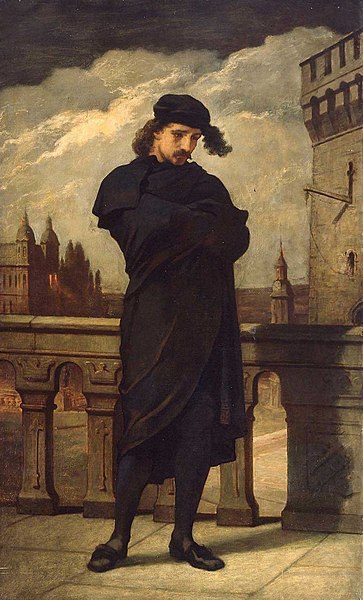
Hamlet by William Morris Hunt.
However, like Goethe with his Faust, this is not entirely accurate. Shakespeare’s Hamlet has to be placed within the matrix of Elizabethan England: a time when Christian doctrine was still taken very seriously, both in its Anglican and Papist versions. Hamlet suffered a schizogenic struggle. He struggled internally with the command of his father’s ghost, from purgatory, to avenge him; but Hamlet couldn’t condemn himself, should he commit the mortal sin of murdering his uncle if he was, after all, innocent: a dilemma with which he struggles internally throughout the play.
So despite being influenced by the free-thinking ideas of his time, like Goethe Shakespeare was playing with Christian post-mortem doctrine. Nonetheless, from the viewpoint of my trilogy, which tries to fulfil Delphi’s mandate, Hamlet certainly represents a breakthrough in insight: it is the first foray into what we may call the true self (as opposed to the false self: the internal struggles we read in Augustine’s Confessions).
What gives Hamlet such evocative power is that the tragedy doesn’t take place on stage but within Hamlet’s soul. The whole play is a soliloquy, and since I have finished my trilogy these days with a postscript to my own tragedy with my father, I would like to quote a few words from Hamlet’s second scene:
Would I had met my dearest foe in heaven
Or ever I had seen that day, Horatio!
My father!—methinks I see my father.
A couple of minutes of the 1948 film interpretation from this point onwards portrays Hamlet’s inward-spiralling soliloquies very well. Incidentally, when I saw that film with my father in 1975 he had already mistreated me.
Lebensborn
‘If we could establish the Nordic race and, from this seedbed, produce a race of 200 million, the world would be ours.’ —Himmler
In heated debates, many commenters on racialist forums continue to discuss Hitler and National Socialism these days, including Greg Johnson (e.g., here).
One of the most recurring themes of Hitler’s critics has been the way the Germans treated the Slavs in WW2. I am enormously struck by the fact that none of them have been able to point out the obvious. It was perfectly natural and laudable that Himmler and his people, who had some Norwegian villages as an almost perfect paradigm of the Aryan, wanted to Aryanise the occupied territories of those who had suffered miscegenation due to the continuous Asian invasions.
Concerned about this issue, while walking through a beautiful little English village I once asked historian Arthur Kemp, author of a book on the history of the white race, a naive question. I asked him what percentage of Russians would be mixed. I say naive as it is obvious that they are already all more mixed than the purest Nordics—the paradigm with which Himmler and his ilk wanted to populate Europe, beautifully portrayed by the American Maxfield Parrish whose paintings now hang on the walls of my studio.
As we said in my anthology ‘On Exterminationism’, a few months after its founding, Himmler’s Lebensborn project opened Heim Hochland, the first home for pregnant women. For this purpose, the National Socialists took over the construction of a Catholic orphanage in Munich. Initially, the institution could accommodate up to thirty mothers and fifty-five children, and the candidates were carefully selected. Only women who met the characteristics of the dominant race were admitted. Candidates had their skulls measured, and only those with the coveted elongated skull, typical of the Nordic type, could be admitted. They also had to meet other requirements, such as blond hair, blue or green eyes and good health. Those who passed the test received the best care.
This fact, that due to the brutal Asian invasions the Slavs’ bloodline was already more compromised than the specimens chosen by Himmler and the SS to repopulate the conquered territories, is completely overlooked by all these critics of Hitler. They overlook it because of their Christian ethics and the mandate of universal brotherhood, so they see all Caucasoids (except Jews) as brothers. It is surreal to admit, but only someone who is not an Aryan, such as myself, has been able to point this fact out over the years in my disputes with white nationalists.
The thing to do is to applaud Hitler’s plans, including his Master Plan East, and only criticise him militarily (easy to say now: he should’ve waited until he had the atomic bomb before venturing into Operation Barbarossa).
What I say in ‘The Wall’ stands, which is why it remains and will remain the featured post of The West’s Darkest Hour. An axiological wall separates National Socialists from white nationalists and very few Americans have crossed it. William Pierce was one of them but it is a wall that very few racialists are, now, willing to cross.
There is something I have perceived and have already said but it is worth reiterating.
In my experience on this site, thanks to the emails sent to me by the more radical commenters I have noticed that only those who were martyred as children or teenagers by their parents have been able to truly break with the values of today’s West. It is difficult to visualize it if you don’t read the autobiography of one of them. But for the sake of understanding I will use an analogy.
Only people like Solzhenitsyn, who suffered years in the Gulag, broke with the ideology of the Soviet state to the extent that, already a refugee in the US, he wanted that state to be destroyed. We can already imagine nationalist Russians in Brezhnev’s time! Despite Stalin’s crimes, it would be unthinkable for them to wish for such a thing because, unlike Solzhenitsyn, they didn’t suffer the horrors of the Gulag.
Only intense suffering makes one break with the paradigm in turn, although I recognise that suffering resulting from parental abuse annihilates psychically almost everyone. That is why I must translate my books into English, something I will restart now that I am beginning to settle down after a very calamitous move.
Lawyer
and prosecutor
I still can’t find a place to move, so I don’t have time to resume my full-time activities for the sacred words. But today, at the bank, and already at home watching a video on how the old left thought (‘How the Left Destroyed Itself’ with Yanis Varoufakis), my mind doesn’t stop its train of thought.
Recall once again the faces of white Mexicans in my recent post ‘Blue pill’. In one of Mexico City’s best-known malls, where I was today because the banks are open there on Saturdays, I saw a huge billboard in the car park showing a Caucasian male with a black couple. I had seen such billboards in London but apparently, they are now catching on in the third world. The West suffers from an endless hatred: an exterminationist hatred of the white race even in countries where, like Mexico, there are very few true whites.
I didn’t take a picture of the huge billboard I saw in the mall with my mobile phone (although as a priest of the holy words I don’t use a mobile phone in a city without friends, for banking matters I have to carry it). But I think we Westerners have seen such billboards in various countries.
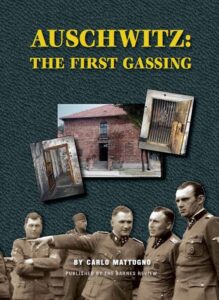 On the other hand I must confess that, although I don’t have time to read at the moment, I find fascinating what I have barely read of the 1455-page Spanish translation, which I recently acquired, of the classic book The Destruction of the European Jews. In digital form, I own the revisionist counterpart: the Holocaust Handbooks series (pic of one of them on the left). It would take a lifetime—many years that I no longer have on my horizon—to assess both sides. Hopefully, future priests will follow my method: listen to both the prosecutor and the lawyer before rendering an educated opinion.
On the other hand I must confess that, although I don’t have time to read at the moment, I find fascinating what I have barely read of the 1455-page Spanish translation, which I recently acquired, of the classic book The Destruction of the European Jews. In digital form, I own the revisionist counterpart: the Holocaust Handbooks series (pic of one of them on the left). It would take a lifetime—many years that I no longer have on my horizon—to assess both sides. Hopefully, future priests will follow my method: listen to both the prosecutor and the lawyer before rendering an educated opinion.
In any case, as we can see from my featured post ‘The Wall’, the priest is not affected by the official story as he is a man who has already transvalued his values. As a Swede said on page 83 of my anthology On exterminationism:
What is certain is that the Holocaust would not have produced any debilitating psychological effect on non-Christian whites. (By Christianity I mean ‘Christian morality.’ Most atheists in the West are still Christian, even if they don’t believe in God or Jesus.) Being emotionally affected by the Holocaust presupposes that you think: (1) Victims and losers have intrinsically more moral value than conquerors and winners, (2) Killing is the most horrendous thing a human can do, (3) Killing children and women is even more horrendous and (4) Every human life has the same value.
None of these statements ring true to a man who has rejected Christian morality. Even if the Holocaust happened, I would not pity the victims or sympathise with them. If you told the Vikings that they needed to accept Jews on their lands or give them gold coins because six million of them were exterminated in an obscure war, they would have laughed at you.
Who within the American racial right, which largely subscribes to Christian ethics, thinks like this neo-Nietzschean Hyperborean?
Christianity:
The communism of antiquity, 6
by Alain de Benoist
This certainty that the Empire needed to collapse for the Kingdom to come explains the mixed feelings of the early Christians towards the barbarians. Undoubtedly, at first, they felt as threatened as the Romans.
Ambrose, Bishop of Milan, distinguished between external enemies (hostes extranei) and internal enemies (hostes domestici). For him, it was the Goths that Ezekiel was referring to when he spoke of the people of Magog. But, in the second stage, these barbarians, who were soon to be evangelised, became auxiliaries of divine justice. Christians could not admit that their fate was linked to that of a ‘Babylon of impudence’. That is why the Carmen de Providentia or the Commonitorium of Orentius are scarcely interested in other than the ‘enemies within.’ In the 3rd century, in his Carmen apologeticum, a Christian author, Comodian, speaks of the Germans (more precisely of the Goths) as ‘executors of God´s designs.’ In the following century, Orosius, in turn, affirms that the barbarian invasions are ‘God´s judgement’ that come ‘in punishment for the faults of the Romans’ (poenaliter accidisse). It is the equivalent of the ‘plagues’ Moses used to blame the Pharaoh.
On 24 August 410, Alaric, king of the Visigoths, after besieging Rome for several weeks, entered the city by night through the Porta Salaria. It was a converse patrician, Proba Faltonia, of the Anician family, who, after sending her slaves to occupy the gate, had it surrendered to the enemy. The Visigoths were Christians, and the spiritual and ideological solidarity bore fruit. The Anicians, of whom Amianus Marcellinus (XVI, 8) says that they were reputed to be insatiable, were known as fanatics of the Catholic party. The sack of Rome that followed was described by Christian authors with kindly strokes. Alaric’s ‘clemency’ was praised. Georges Sorel asked: ‘Were the vanquished guilty?’ St Augustine says of the Visigothic leader, he was God’s envoy and the avenger of Christianity. Oretius says that only one senator died and that it was his fault (‘he had not made himself known’), and that it was enough for Christians to make the sign of the cross be respected, and so on. ‘Such daring lies, says Augustin Thierry, were later admitted as indisputable facts’ (Alaric).
Around 442, Quodvulteus, bishop of Carthage, claimed that the ravages of the Vandals were pure justice. In one of his sermons, he tried to console a faithful member who had complained about the devastation: ‘Yes, you tell me that the barbarian has taken everything from you… I see, I understand, I meditate: you, who lived in the sea, have been devoured by a bigger fish. Wait a little: an even bigger fish will come and devour the one who devours, despoil the one who despoils, take the one who takes… This plague that we are suffering today will not last forever: in truth, it is in the hands of the Almighty’. Finally, at the end of the 5th century, Salvianus of Marseilles affirms that ‘the Romans have suffered their sorrows by the just judgement of God’.
In the 2nd century, the City had been invaded by foreign cults. A temple to the Great Mother had been erected on the Palatine Hill, where fanatici officiated. Moral contagion did the rest. ‘Through the gap opened in the barrier that closes the horizon of terrestrial life, they were going to penetrate all sorts of chimaeras and superstitions, drawn from the inexhaustible reservoir of the Oriental imagination.’ (Bouché-Leclercq). These were the bacchanalia, the rites with mysteries, the Isiac cult, the cult of Mithra, and finally, Christianity. The words ‘The last of his family’ were written in the tombs more frequently. Pompey’s line had disappeared in the 2nd century, and also Augustus’ and Maecenas’ lines.
Rome was no longer Rome; all the rivers of the East flowed into the Tiber. It was only much later, in the Renaissance, that Petrarch (1304-1374) observed that the ‘black epoch’ (tenebrae) of Roman history had coincided with the era of Theodosius and Constantine; while in northern Europe, in the early 16th century, Erasmus (c. 1469-1536) claimed, although he called himself a ‘militiaman of Christ’, that the true barbarians of ancient times, the ‘real Goths’, had been the monks and scholastics of the Middle Ages.
2 founding fathers
In the middle of the year I added a post in which I was alarmed about the existence of serial child killers in the US. These last few days, however, I have seen a lot of videos of horrific murders committed by American adults on other adults.
I won’t mention the names of the perpetrators, which you can easily find out by looking them up on YouTube. Still, I am now thinking of a young Aryan lad in whose room his mother found a bag containing a human head (in police interrogation the lad gloated that he had destroyed the corpse’s eyes with a knife); a woman who had killed her mother and hid her body in the garage until the cops found her; another woman who killed seven of her newborn babies and collected their corpses in boxes that began to smell bad; a man who suffered from the same disease that depressed Robin Williams but, unlike the famous actor, butchered his wife with a small but sharp knife (the video reveals that the policeman who entered the crime scene had to get out and throw up the turkey because of what he had seen, as the day before had been Thanksgiving Day), etcetera.
There is no doubt that American society is sick. But the serious thing is that practically no one, not even white nationalists, realises the causes of the spiritual sickness that has befallen their society. Only Americans like Francis Parker Yockey began to sense the cause, but his best-known work, Imperium, was written in prose so opaque that, in my opinion, it is no longer of any use to us in this century.
Writing in prose so clear and transparent that the essentials can be said in a short blog post, the darkest hour (Kali Yuga) not only of the US but of the West began in 1945. Two of the featured posts that can be read on the menu of this site, ‘Founding Myth’ and ‘The Iron Throne’ deal with the matter and I need not repeat myself. What I would like to clarify today is something else.
I have recently said some very harsh things about the ‘Founding Father’ of the Americans, George Washington, because of his philo-Semitism. But I, born south of the Rio Grande, could say the same about the Founding Father of Mexico: Hernán Cortés.
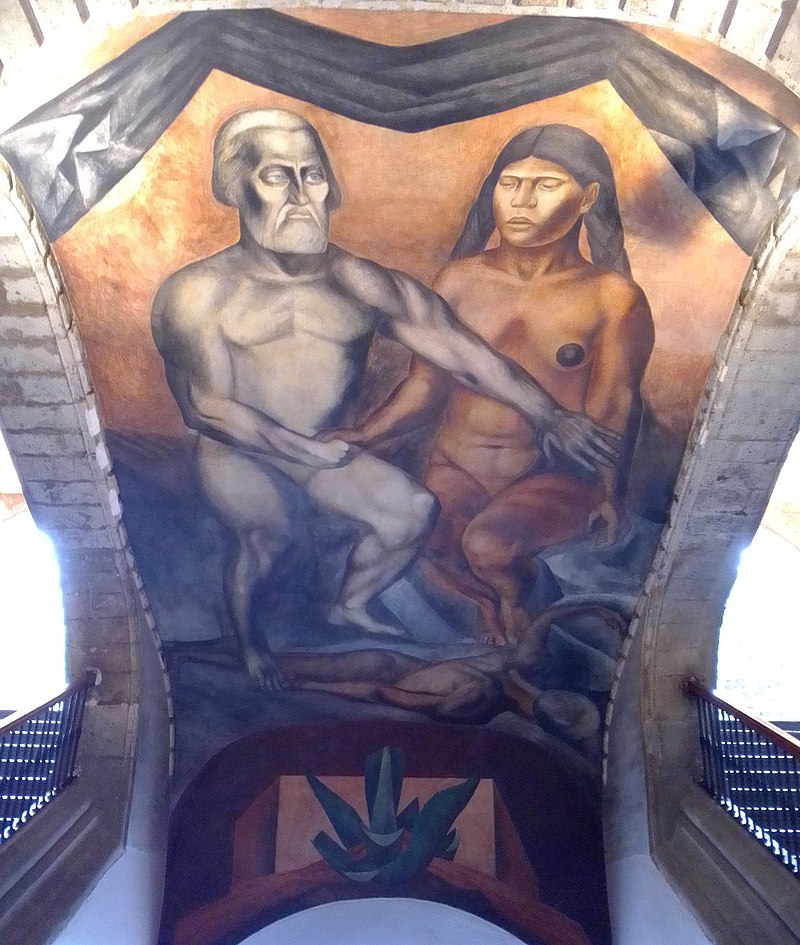
Cortés and La Malinche is a mural by José Clemente Orozco frescoed in 1926. It is preserved on the main staircase of the Antiguo Colegio de San Ildefonso, located in the centre of Mexico City.
Cortés not only conquered Mexico-Tenochtitlan in 1519-1521, the seat of the Aztec empire, but also initiated the interbreeding of Iberian White and American Indian. One need only travel to contemporary Mexico to see the ravages of this miscegenation sanctioned by both the Catholic Church and the Spanish Crown.
Now, as I have also said recently, the pre-Christian Visigoths of ancient Hispania burned at the stake any couple who dared to procreate a mongrel baby. What a reversal of values between this taboo of the pagan Goths and the 16th-century mixing perpetrated throughout the American continent! (remember that a large part of what is now the US belonged to New Spain).
This miscegenation on a scale never seen before was, in my opinion, worse than Washington’s philo-Semitism because it condemned the newly discovered continent to perennial underdevelopment, at least in the part that was colonised by the Spaniards and the Portuguese.
By expressing myself in this way about the country of my birth, I have become such an outcast that I have not a single friend, so I never carry with me my cellphone (which I only use for my bank account). But what I want to get at is that, if I express myself in this way about Cortés and the Iberian conquistadors who mixed their blood, why shouldn’t I also express myself harshly about the Founding Father of the neighbouring country to the north and his philo-Semitic epigones?
The dissolution
of Germanic racial care by medieval Christianity (5)
by Hans F. K. Günther
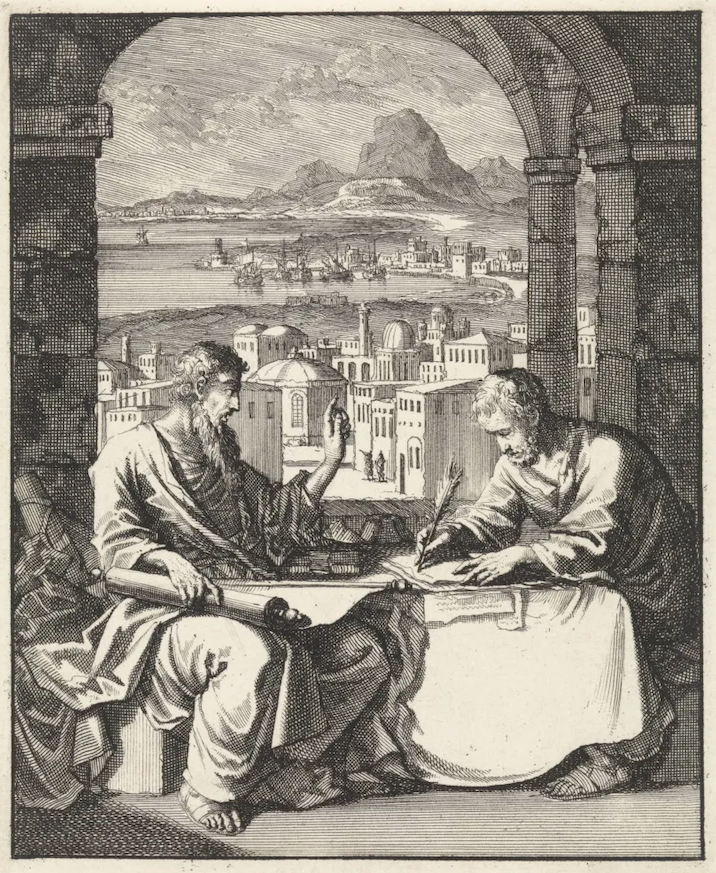
Jan Luyken’s 1698 engraving of the quintessential subversive Jew, Paul, dictating his famous Letter to the Romans to his scribe.
Baher also saw the price of poverty, which must have seemed to the hard-working German peasant the price of inability to work at a time when there was still enough free land to clear and cultivate. For him, poverty was the appropriate fate of the incapable, not the state in which a person was closer to the Kingdom of God. Baher is the price of the weak and sick, the suspicion found in appearance as a sign of spiritual contamination (see p. 377). In the Epistle to the Romans (12:16) Paul warns: Do not aim at high things, but lower yourselves to the lowly – this was the negation of Indo-Germanic values such as pride, the drive for power, the joy of owning land, of competing with all the forces of the region. The medieval pious person was led away from these Indo-Germanic values to values of courage, i.e. according to the root of the word (serve): of being a servile person, of being homeless, celibate and without possessions.
This transformation of values through the ecclesiastical teachings of the Middle Ages was characterized by one of the best experts on pagan Germanic culture, Andreas Heusler:
It is deeply unscriptural that one openly and joyfully admits to pride and the drive for power. Anyone who has what it takes should want to be the first in their region. The sentence that he who humbles himself finds no place in these hearts. The will to power has the affection of the narrator and the listener. With compassion one follows the self-confident man who is bowed down by fate. Something new in the Christian stories is the look of satisfaction that touches the fall of the powerful. To the extent that bias and malicious joy prevail in the sagas, it is directed less against the tyrant and oppressor than against the coward and the quiet, even against the upstart.
The teachings of the medieval church thus dissolved the Germanic focus on a human image of spiritual perfection and a noble lifestyle, and instead taught the characteristics of those who had been described by the Germanic people as litilmenn, as people with small souls. The new doctrine thus eliminated the original model of the volatile, noble and beautiful person. This had to have an effect over the centuries and, together with other historical forces, resulted in us Germans being racially and genetically different from the Germanic peoples.
The racial history of the Germanic people as such ends with the conversion of the Germanic people to Christianity. It begins with the period between the 9th and 11th centuries when the barrier between the free and the unfree, here earlier, there later, at the latest in Lower Saxony and in Scandinavia, there only completely in the 14th century, the mass history of the individual Germanic-speaking tribes, in Germany the racial history of the German people, fell. The German people of the later Middle Ages and the modern era already presents itself as a selection result of those centuries in which the racial breeding of the Germanic people, which had returned to Indo-Germanic roots of the Neolithic period, had been dissolved.
______ 卐 ______
Editor’s 2 ¢
As far as the last paragraph is concerned, since I have Spanish ancestry it came to my attention in William Pierce’s Who We Are and Arthur Kemp’s March of the Titans that the Visigoths of ancient Hispania only began to interbreed after the introduction of Christianity. A century before the Moors invaded the peninsula, these pure Aryans had terrible punishments for the mixed couple who dared to procreate a mongrel baby. Why are these historical facts that Hans Günther and others talked about not mentioned in the forums of the American racial right?
I think we already know the answer…
of Germanic racial care by medieval Christianity (2)
by Hans F. K. Günther
In many areas of Sweden and Norway the racial barrier between free and unfree fell much later than in southern Germania, because Christianity penetrated there much later. In Sweden there were many unfree servants who had been imported from Finland, from areas of predominantly non-Nordic race. Sweden seems to have had the largest number of unfree people around 1200, although by then many people had already been freed under southern Christian influence. But there were still many unfree people in Sweden up until the 14th century, most of them probably in Uppland, the region opposite the Finnish coast, where the need for servants was greater due to the seat of the kingdom and the estates of the powerful large farmers. In some areas of Uppland there are today relatively many short-headed people with broad faces, pronounced cheekbones and features of the Baltic race, which are more common in Finland. When the serfs in Sweden became free around 1200 and later, these people moved to the undeveloped and inhospitable areas, as there was still enough cultivated land. In many cases, the names of settlements and villages indicate that such places were cleared and founded by freedmen. But in these areas, the people are mostly darker in skin, hair and eyes than other Swedes, and at the same time more shy, simple, distrustful and religious in their souls, and not as open and frank as other Swedes. Thus, according to research by Rihtén, despite some later mixing of the populations, there is still a racial difference between the descendants of former freemen and those of former serfs.
Another abolition of the idea of ancestry and ethnic origin was brought about by the idea of redemption – this idea itself was such a characteristic idea of the Near Eastern racial soul that Claus combined the spiritual traits of the people of the Near Eastern race to form the image of the ‘redemptive man’. The redemption taught by the church should, however – and this is the essential difference compared to the traditional racial cultivation of Germanic culture – at the same time bring about a liberation and rejection of species, tribe, language and people, which here appeared as something restrictive and degrading. The ‘Revelation of John’ (5:9) taught that God had redeemed people through his blood from every tribe, every language and every people (ex omni tribu et lingua et populo et natione).
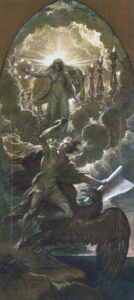
A Jew of the Hellenistic-Roman era could, under certain circumstances, see his nationality as something repulsive and something to be discarded. There were many at that time who detested the Jewish people; there were also some Jews who saw their people as inferior to the Hellenes and Romans. Josephus, for example, the Jewish historian on the side of the Romans besieging Jerusalem, felt this way as a citizen of the world with a Hellenistic education. But now the Germanic peoples were supposed to see their tribe, their language and their way of life as something from which they had to be redeemed. Through priestly instruction, the spirit of the East now influenced the West.
In my work Piety of a Nordic Kind (1934) I tried to show why the idea of redemption in all its interpretations and effects must have seemed completely alien to Germanic culture at first: redemption from what evil and to what other life? Midgard, the world of sensible order, the cultivated homeland, was his evil, was in fact something divine, and Utgard, the power of the anti-divine, was to be fought on the side of the god. There could not be a better life than the combative life on this earth and in friendship with God. It was precisely as a pious person that the Germanic people possessed the security described above and, as a nobleman and descendant of select aristocratic peasant families, the certainty of good nature. Now Midgard was to become for him a scene of original sin and frailty in need of redemption, his very nature bound to the disgusting ‘flesh’ that leads to sin, something sinful from which a soul separated from the body must strive for an afterlife. All human nature was corrupted in its infancy, ‘evil from birth’ (Genesis 8:2) and created from ‘sinful seed’ (Pyalm 51:7). According to this doctrine, it was no longer possible, as it seemed to the Indo-Europeans, that something divine could manifest itself in human races; rather, everything human was inherited, unworthy before God and therefore dependent on redemption, redemption through a blood-stained head.
For the reasons stated above, no evidence has survived of the effect such teachings had on the Germanic mind. This mind probably opposed them with a similar resistance to that felt by Goethe, who rebelled against the doctrine of original sin and wanted to see certain phenomena recognized as an ‘inherited virtue.’ We also know of Goethe’s indignation at Kant’s idea of ’radical evil’ in man – Goethe was certainly too good a connoisseur of reality to overlook the fact that the majority of his contemporaries could probably provide examples of something ‘radical evil.’ but he refused, out of what one might call an Indo-European feeling, to understand this ‘sad evil’ as something necessary and essential to the human species and to all types of people, and believed that Kant had introduced this view into his teachings in order to attract Christians to his philosophy as well, as he wrote in his letter to Herder on June 7, 1793.
The Germanic peoples may have felt something like this in relation to the medieval church teachings. An idea such as that expressed by Luther in his baptismal book (1526), that the child before baptism is possessed by the devil and a child of the devil; further an idea such as that expressed by the Augsburg Confession (Confessio Augustana) and the Formula of Concordia (Formula Concordiae), the obligatory foundations of the Germanic Church, that a person conceived and born of the devil cannot have a true faith in God by nature; that there is nothing found and uncorrupted in the body and soul of man and that he is therefore not only unwilling but completely incapable of doing good and that his whole nature, person and being is completely corrupted by original sin. Such ideas, in contrast to Germanic-Indo-Germanic thinking, can only have entered the minds of the descendants of converted Germanic peoples after centuries of appropriate interpretation. Individual Germanic tribes have certainly tried to interpret the church teachings in a native sense; one such attempt, which may have seemed strange enough to most Germanic tribes of the time, is represented by the Old Saxon Geltand-Bichtung of the 9th century. The sober-minded among the Germanic noble farmers – and sober thinking was always widespread among the farmers of predominantly Nordic origins – may have initially perceived the church teachings somewhat in the same way as Frederick the Great did according to his living will of 1768.
